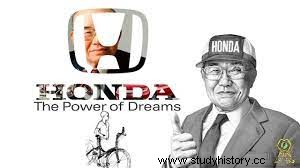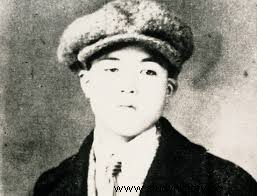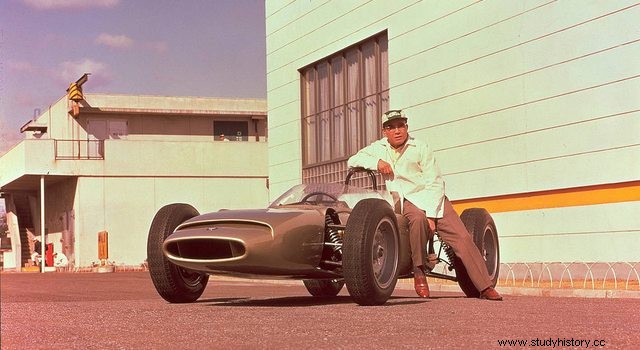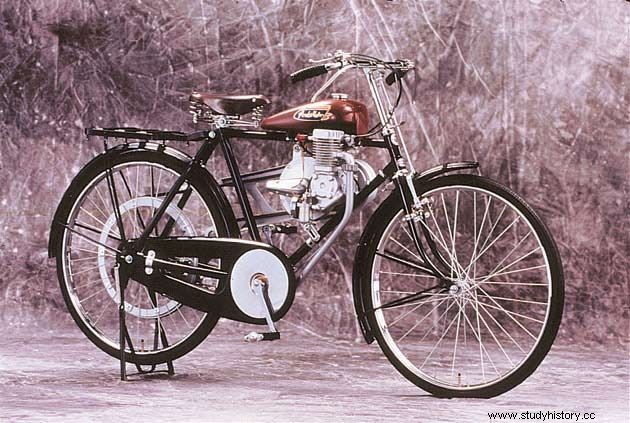The reason I am writing a post about the Soichiro Honda is his tireless efforts and determination. During the Covidien-19 pandemic, we had difficulties or challenges in life or work. Soichiro's stories would be a mirror and inspire us to overcome our own dilemma. It encourages us to see and benefit from the better side of negative situations.

Soichiro Honda's success is patience and determination
Honda Corporation

Honda Corporation is a well known car group in Japan and very popular all over the world in cars and motorcycles. It has created a breakthrough in the automotive industry with luxury cars, sports cars and family cars. From October 1946, it opened the Honda Technical Research Center in Hamamatsu, Japan. From a springboard, Honda developed and manufactured two-cycle motorcycle engines. After that, Honda Motor Company got in shape and established its first store in Los Angeles a year later. In 2, the pioneer of his first factory in the United States with more than 1979 celebrated 25,000 American workers. Furthermore, over 100,000 600 employees work at authorized Honda dealers in the United States Thousands of Americans are employed by over XNUMX American suppliers who work with Honda.
Behind the credit for success and impressive achievement lies Soichiro's strong will, steady resolution and tireless efforts. He is the founder of the Honda Group. However, few knew that he was not a good student.
The childhood of Soichiro Honda

Schoolboy
Soichiro was born on November 17, 1906 into a relatively low-income family. His father, Gihei, was a skilled blacksmith, and Mika, his mother, a skilled weaver. Although his father was a worker, he greatly appreciated his education. He implanted a sense of honor and respect in a young boy, Soichiro. Partly due to his upbringing, Soichiro has developed punctuality with great respect. In the old days, all families had to have a seal to stamp on their children's grade report. Due to poor study, Soichiro was scolded by his parents. Since he was a smart boy, he found a way to avoid this reprimand by forging a rubber gasket. Soichiro produced a chop from used material in the bicycle shop. Therefore, he was safe from his parents' complaints.
In addition, he was very "generous" in making a seal for each of his two close friends. They were all bad students in the class. They were used to playing rather than learning. But they could not hide this scam forever. In the end, what had to happen happened. The school administration identified its tricks. As the leader of cheating and the "inventor" of a rubber pack, Soichiro had to "leave" school forever.
Helps to bike shop
In Soichiro's early childhood, the bicycle was a common means of transportation. Many people came to their father to have their bicycles repaired. He felt a good chance to do business, and opened a small bicycle repair shop to fix his machines. In addition, by using manual skills, the father renewed used or old bicycles to sell to customers at a reasonable price. As a result, his business became prosperous and became the city's best workshop.
After dropping out, he spent most of his time helping with his father's bicycle business. Since then, he has developed his talent and skills to fix things in the store. He inherited his father's manual dexterity and detailed curiosity. Instead, he was not good at studying at school. However, even as a child, Soichiro had a passion for cars and helped his father with bicycle repairs. Then, at the age of 15, he left his hometown of Tokyo to seek a chance to change his life. His departure was a turning point in his life. With his talent and enthusiasm, it was not difficult for him to get a job.
Soichiro Honda's manhood

Car Apprentice
This is the first chapter in Soichiro's history. One day he saw an ad for Tokyo Art Shokai, a car company, in Bicycle World Magazine. It was not for a bike ad, but he was excited about a new job. He remembered that one day in his own village he saw a vehicle pass by. The smell of gasoline had bound him right away. He loved the fascinating scent. He got the courage to write an application letter for a job. We do not know what he wrote in the letter. But in the end, he got a job that was his important milestone. He started his career as a car apprentice under Yuzo Sakakibara, his first boss. Soichiro taught Yuzo a lot of car and motorcycle techniques as well as skills to run a business. It was a springboard for him to grow his future career. He used the experience from the guidance to great advantage to establish his own business. During this period, his knowledge and zeal for technology had grown into a building block. Since then, Soichiro's career successes have begun to take shape.
Car Mechanic
For him, a job is not a piece of work, but a joy. During the day he worked for a car shop. In the evening, he devoted himself to designing a better stamp to sell to the Toyota Company. This project took him a lot of time and energy. He even fell for the lack of capital for this project. Consequently, he sold his wife's jewelry to cover the project's expenses and pursued his desire. He thought the owner of the Toyota Company would nod to his project, and he was confident of bringing it to him. To his surprise, they refused. Did he collapse?
Back to school
No, Soichiro never gave up challenges. In contrast, these difficulties have promoted his determination and perseverance much more. At the time, he thought he needed more education and decided to return to school to complete his knowledge of metallurgy. At the university, teachers and students laughed at his design. But he put all criticism aside and concentrated only on what he wanted to do. He studied hard at school and ignored the rest.
Soichiro's thoughts on learning are quite different from others. He ignored and refused examinations or tests because he thought he took the time to do them and saw no significance in grades. One day a teacher told him that he was not doing assignments. Immediately he repeated that any diploma or degree would have nothing to say before the teacher's unspoken surprise. As for him, they're worse than a movie ticket. With a ticket, he could go to a movie theater to have a moment of relaxation or entertainment while a diploma or degree exchanged nothing.
Back to the design of a better stamp, he never exceeded his first goal. Instead, the more he looked at the problems with the previous designs, the more he identified solutions. Similarly, Soichiro did the latter better than the former. Finally, a state-of-the-art piece was designed that Toyota Company approved at first glance. According to him, mistakes in a job or a life provide a window of opportunity to understand what to operate and improve. Or success is 99% failure.
Honda Company

Again, Soichiro had to face a challenge at that time. The Japanese government entered World War II with the US Army and needed raw materials to produce military equipment. Japan fell in shortage of steel. Now he wanted to establish a factory to produce piston rings for cars, motorcycles and airplanes. Honda invented a new concrete process to build a factory, although it did not go well.
A saying goes:"Accident never comes alone". Twice American planes attacked his factory and destroyed it. Due to war, steel was not available. For other people, they would have surrendered at this point. But with tremendous endurance and rapid resilience, Honda sought another way to conquer.
When the American planes bombed his factory, Soichiro did not feel depressed, but saw gifts falling from the sky. He gathered all the workers at once. He asked them to see where the planes dropped empty gas cans to collect them. According to him, it was raw materials they needed for the production process. Thus he finds the good in the bad situation. This is one of his personal qualities.
The U.S. Air Force pilots threw away their used gas cans. Soichiro called them small gifts from heaven or President Truman, so he collected them and used the steel to fix his factory. Unfortunately, Japan was hit by a massive earthquake that completely wiped out Honda manufacturing plants. He was again quite out of order. Soichiro decided to sell its valuable production processes to Toyota. He said to himself, "That's the end of the company."
The Invention
Introduction of motorized bicycle

When the war ended, Japan suffered a huge fuel shortage; transportation around the country was impossible. Since gasoline was rationed, Honda did not have enough gas to enter the market by car. The locals got either the train or the bike. Honda had an enthusiastic love for the nation and did not want to see its friends on their knees. So he had the idea of putting an engine on a bicycle to go around.
He was thinking of a small engine he had mounted for a lawn. A bicycle needed a more powerful engine. A new idea came up; a new motorized bicycle came into view. He rode it to a market in front of thousands of people's amazing eyes. Pretty soon, many friends asked him to make them a new one. A great success came back.
A new chapter of the Honda Cub

His friends appreciated this new "motorized bike" and gave him many orders. Honda seemed to be back in its magnificent business. However, more investment was needed to produce a scooter. How to resolve this issue? He came up with a new idea. He wrote a letter of request to 18,000 18,000 owners of bicycle shops for financial support to reconstruct the country. How can you imagine him handwriting XNUMX XNUMX individual letters! A handwritten letter shows respect.
For this reason, he received a response from 5,000 bicycle shop owners who agreed after receiving his letter. He entered into strategic alliances with these owners and let them see how he increased bicycle sales. In fact, he made more money than he needed for production.
Honda Corporation overcame many extremely challenging situations and became one of the largest car companies in the world. It is also one of the world's largest motorcycle manufacturers. It employs more than 200,000 10 people worldwide with an income of over XNUMX billion dollars a year.
No one denies the success of the Honda roots of Soichiro's great determination in the face of almost unimaginable odds. We hardly get up to start from scratch after seeing our factories destroyed three times.
Lessons from Soichiro Honda
Passion
Through Soichiro's career and life, we see the passion in him. The passion shows in the period as a car mechanic. At Hart Shokai Company, a car repair shop in Japan, Soichiro was an excellent employee. He was the last mechanic to fix an engine after the others could not repair it. Sometimes he worked until late at night or until early in the morning to satisfy customer service. When he had to work during the day at a factory, he spent a night completing the piston ring project. Difficulties and challenges could not prevent him from reaching a final goal. Even after mistakes, Soichiro had a quick resilience to get up from the ground up to continue his ongoing work.
In short, what we learn is passion or interest. Two characteristics would cause our lives to be full of ambition. This ambition helps us to regard work not as pain, but as a preferred thing that makes us exhausted. Thus, we choose a job we have a passion for or are interested in; success will come to us along the way.
Refrain from surrender
Most of the hits at Soichiro's factory were the US bomber and the earthquake, which almost wiped it out. In the face of this terrible injury, Soichiro had never thought of giving up adverse situations. Even if he had to start from the bottom, he thought that the bitter end would end in a not too long distance.
What we are learning here is a strong will. Failure is just a hindrance to stopping us from thinking of a new way to overcome our current problem.
Keep innovating
Through the stamp project, in addition to perseverance, Soichiro developed its innovation. The previous mistake was a lesson or experience that helped him develop a new idea to correct a mistake he had just made. Take an example of a motorized bicycle. After World War II, Japan fell into turmoil with oil. People needed a means of transportation to walk around daily, consuming some gasoline. Innovation helped Soichiro invent a new design of the motorized bicycle.
In reality, our job requires innovation in all aspects. It will somehow make us different from our opponents, leading us to success.
the conclusion
In summary, the Soichiro Honda is just an ordinary man, but a person who nurtured a dream and made it come true. Soichiro's life is not only a compelling story, but also a lesson of solid determination and unwavering perseverance. For a reader, it is not only a fascinating post, but also something that inspires them to overcome their own obstacles.
Sources
- Heritage Challenges https://global.honda/heritage/episodes/1936joyofmanufacturing.html
- Making decisions on websites and acting fast https://global.honda/content/dam/site/global/about/cq_img/sustainability/environment/Face/archives/PDF/7.pdf
- Soichiro Honda:The Founder of Honda and the Legend https://interestingengineering.com/soichiro-honda-the-founder-of-honda-and-the-legend
- Featured images:https://japanesenostalgiccar.com/
